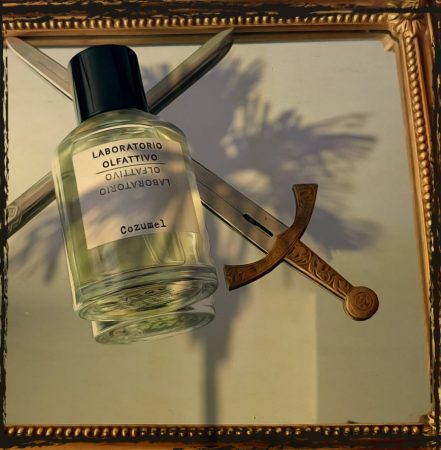
Laboratorio Olfattivo Cozumelphoto by Nicoleta©
If the name rings a bell, you probably have seen it tagged in images of spectacular coral reefs and underwater paradisiac sunken worlds, as Cozumel is one of the most breath-taking (pun intended) snorkeling and diving spots in the world. Located in the Caribbean Sea, along the eastern side of the Yucatan Peninsula, Cozumel has managed to keep its rugged and untamed beauty, making it a perfect destination for anyone seeking to explore a vacation spot that would provide both a taste of wild adventure and all the pampering leisures of a luxury vacation. And with its rich history and amazing heritage, you will get more, much more than an #instamagrable vacation. Let’s scratch at the surface of its history, using Laboratorio Olfattivo as our olfactory tour guide.
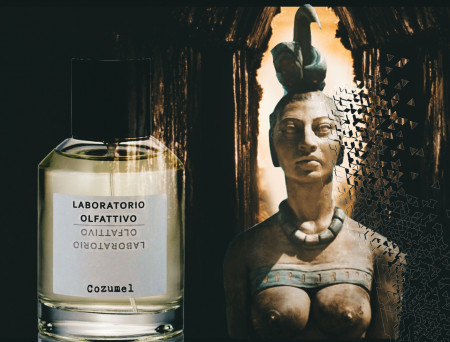
Collage: The fountain 2006 a statue of Ixchel, and Cozumel © Nioleta
The island was a pilgrimage center during the Mayan period (250 – 900 A.D.) where women would come from all over the land, even from places as far away as what is now Belize or Guatemala, to pray in the temples of Ixchel, the goddess of fertility. The tradition dictated that at least once in her lifetime, every Maya woman had to make the pilgrimage to Cozumel and take on the current-filled canoe trip from the mainland to the temples of the island. After the long and perilous journey, the pilgrims could finally give offerings and receive the blessing of the goddess in the temples of San Gervasio – parts of which still stand today in the center of the island. The pilgrims could also meet the ah-men (the Mayan doctors, translated as he/she who knows) who were responsible for keeping the balance between nature and the spiritual world and who believed in the healing power of plants, assigning hot and cold descriptors when choosing the right plants for treating a disease (for instance, a venomous bite would be treated with “cold” green plants because a snake’s bite was a “hot” condition).
Cinematic sequence: Arriving at the temple, crisp dawn. Placing the offerings at the altar of the goddess, you submerge your hands in the cool pond of ice-cold water with green leaves floating on top. You wash your face and reawaken to the voice of the ah-men, rhythmically chanting their incantation, hands rapidly moving, crushing the bitter, aromatic herbs on the stone that serves as a mortar. You place the satchel with the precious medicine around your neck, under your shirt, and slowly begin your ascent to Ixchel’s statue. Having been told never to look the priest in his eyes, you keep your gaze to the floor while climbing the narrow path to the top, so narrow that it forces you to graze the walls as you pass, dusting microscopic ghostly remains of gum and crushed shells on your skin. As you approach the top and see the silhouette of the statue, your hands reach for the small satchel pressed to your chest. Heated by your raising pulse, the herbs will release a new, hypnotic smell. Reality glitches into the next frame.

Zoltan Tasi via Unsplash, edit by Nicoleta
The Spanish came in 1518, and Juan de Grijalva, arriving on the island on the Holy Cross Day (May 3rd) proclaimed the land as property of Doña Johanna and Don Carlos Kings of Spain. In 1519, the infamous Hernán Cortés expedition came and persuaded the chief of the Maya to peacefully submit and accept the Christian faith, proceeding to the destruction of many of the temples and religious shrines and sculptures of the island. One member of the Spanish crew had smallpox, a disease that had not existed in America until then, and in a short time, the disease wiped almost all the inhabitants: only a few hundred survived, out of the 20.000 Maya who lived at the time on the island. By the time the expedition of Cortés left Cozumel, the ancient civilization was in complete ruins and almost depleted of its population. Over the years, pirate attacks grew in frequency, making life on the island very dangerous, and pushing the remaining survivors to move to the mainland. For the following 200 years, the island was completely uninhabited, except for pirates, who used the island as a headquarters for their quests, its caves, cenotes, and remains of Maya sites providing excellent hiding places.
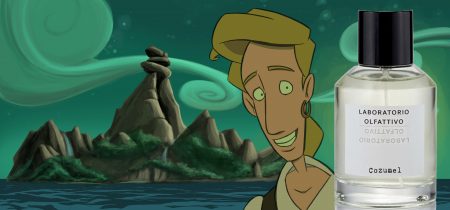
The Curse of Monkey Island game artwork and bottle of Laboratorio Olfattivo Cozumel ©Nicoleta
Flash of synesthesia synched with old gaming memories, back when Lucas Arts (videogame company founded by THE George Lucas) wove their magic unto antediluvian floppy disks. At this point, the perfume feels like a mixture between Indiana Jones & the Fate of Atlantis (the title is pretty self-explanatory) and Monkey Island (a point and click adventure game series where you follow the ill-fated Guybrush Threepwood as he struggles to become the most notorious pirate in the Caribbean).
Cinematic sequence: In the heart of Laboratorio Olfattivo Cozumel, we leave behind the smells of underground water-filled corridors, stone puzzles, and ancient aliens and are easing into the new scenario: the pirate smellscape universe. On the sun-drenched deck of the ship, with hands still burning from lowering the sails, you are eagerly preparing to dock the ship to the island. Around, ship mates are preparing the supplies for the expedition, in the chaotic dance that precedes any descent: the young buccaneer cursing while trying to unravel the tangled hemp rope coils; the satchels filled with dry tobacco leaves, tingling everyone’s nose with their rich, almost honeyed warm aroma. The soft breeze brings wafts of milky coconut promises from the island, and the hot Mexico sun is sizzling on your adrenalized skin. Everything’s melts into the background creamy, woody, olfactive bubble of the ship.
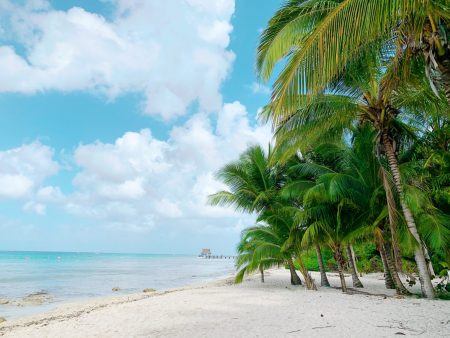
Photo by Fallon Michael on Unsplash
In our days, Cozumel still proves to be a magnet, drawing in visitors from all over the world, as the island is ringed by 30 coral reefs that, that together with the crystal clear transparent blue waters make it one of the most spectacular diving sites in the world. But …there is still certain energy connected to the place. “Even today,” notes a local historian, “we still find straw figures and other offerings at Ixchel’s shrine”. There seems to still be an aura of the sacred hovering around the site, and Mexican women still make pilgrimages to Ixchel’s shrine, where, in a little box in front, flowers, coins, and incense are left as offerings to the goddess. In the dry down the fragrance floats on introspective incense, the creamy sandalwood fading into woody cedar, with a beautiful, dark, and multifaceted tonka comes into play (the tonka that Marie Duchene masters at black-belt level, see Tonkade for reference). From top to bottom, Laboratorio Olfattivo Cozumel is a perfume that feels like an incantation, with a rhythmic metronome-like tempo, changing sceneries from cold to hot and from green aromatics, through multifaceted tobacco and hemp-infused creamy sandalwood to meditative and ritualic incense. Absolutely gender-fluid, it manages to conjure an immersive guided meditation into a paradisiac setting with more layers than one would expect.
Overall, Laboratorio Olfattivo Cozumel made me feel like I’m browsing through the miscellaneous objects section of an olfactive inventory, mixing and merging the notes to solve the puzzle that will unlock the final boss fight. Aromatic healing herbs, cool and green savory basil, hemp rope, blonde tobacco, cleaning sage, and holy incense? As with any riddle, once as I figured out my answer, all the pieces of the puzzle fell into place. Of course, your answer may differ from mine, and that’s the beauty of perfume – how anyone can create his own narrative to make it “dance” on your skin to the rhythm of your own drum.
*Also see my reviews of Tonkade and Vanagloria from Laboratorio Olfattivo.
Other reviews include: Nerotic, Nun and Mylo, Patchouliful Kashnoir Daimiris and Alembar
**Notes about Cozumel gathered from Hajovsky, The True History of Cozumel; Mayan Medicine: rituals and plant use by Mayan Ah-Men by Kaylee Doemel; Wikipedia
Notes: Top: Bergamot, Vietnamese Basil, Aromatic Notes, Heart: Clary Sage, Indian Hemp, Blonde Tobacco, Amber, Base: Sandalwood, Cedarwood, Incense, Tonka bean
Nicoleta Tomsa, Senior Editor
Disclosure: Bottle kindly provided by Laboratorio Olfattivo, opinions are my own
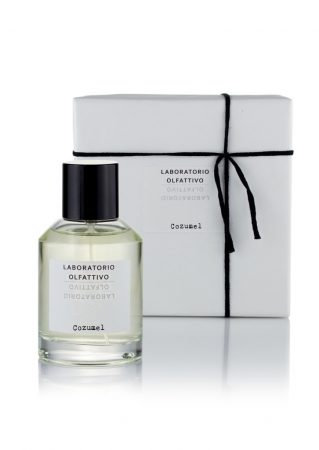
Laboratorio Olfattivo Cozumel official brand photo
Thanks to the generosity of Laboratorio Olfattivo we have a 100 ml of Cozumel bottle for one registered reader in the USA and EU. You must register or your entry will not count. To be eligible, please leave a comment saying what sparks your interest based on Nicoleta’s review and where you live. Do you have a favorite Laboratorio Olfativvo perfume. For your comment to count twice,let us know if you do, and which other you would like to try here. Draw closes 8/31/2021
Follow us on Instagram @cafleurebon @nicoleta.tomsa @laboratorioolfattivo @kaondistribution @marie.duchene_ribaric @RobertoDrago1
This is our Privacy and Draw Rules Policy
We announce the winners only on our site and on our Facebook page, so like Çafleurebon and use our blog feed… or your dream prize will be just spilled perfume
Like our Facebook page: Çafleurebon and use our blog feed for new updates and articles
